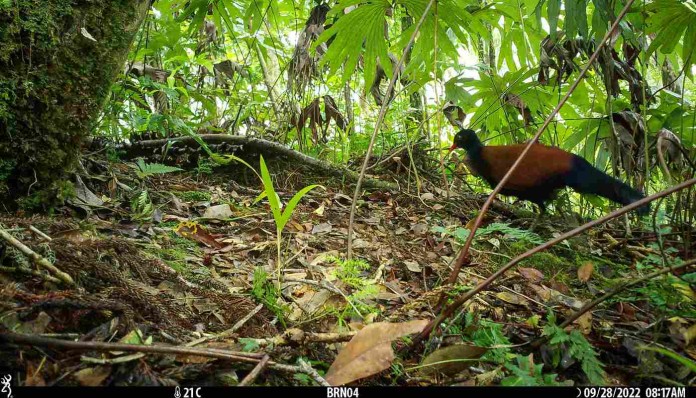The newly-discovered species belongs to Trichothraupis, a genus that was established in 1851 and, until now, included only one species: the black-goggled tanager (Trichothraupis melanops).
These forest-dwelling birds live in pairs or in small groups, and feed on fruit and arthropods, regularly feeding on army ant swarms.
They are common in the Atlantic Forest, where they are bold, conspicuous, and easy to observe. However, they are less conspicuous in the Andes, where their main habitat consists of drier forests than in the Atlantic regions.
“Trichothraupis is a monospecific genus found in two disjunct populations, one in the Atlantic Forest of eastern Brazil (Bahia south to Rio Grande do Sul states), northeastern Argentina, and eastern Paraguay, from sea level up to 1,200 m,” said Dr. Vagner Cavarzere from the Universidade Estadual Paulista and his colleagues.
“Normally associated with the Atlantic Forest, there are some isolated populations in the southern Pantanal as well as in the gallery forests of eastern Chaco.”
“A second population can be found on the eastern slopes of the Andes from northern Peru to extreme northwestern Argentina, mainly from 1,000 m to 1,700 m.”
A recent study demonstrated that the Atlantic and Andean populations of Trichothraupis melanops are genetically isolated, and therefore, that the current classification as a monotypic species should be revisited.
In a new study, Dr. Cavarzere and co-authors evaluated the morphology, plumage, and vocalizations of the Atlantic and Andean populations.
The researchers examined a total of 581 skin specimens housed in museums around the world.
“Our study of plumage revealed full diagnosability between the two populations of Trichothraupis,” they said.
“Both populations are also differentiated by tarsus length, with the Atlantic population having longer tarsi on average.”
“Additionally, the taxa inhabit distinct vegetation types (Atlantic Forest versus Tucumano-Boliviano and Yungas montane forests).”
Named Trichothraupis griseonota (common name is the Andean black-goggled tanager), the new species is found from 400 m up to 1,700 m on the eastern slopes of the Andes in Peru, Bolivia, and northwestern Argentina.
“Trichothraupis griseonota is restricted to the eastern slope of the Andes of central and southern Peru, Bolivia, and northwestern Argentina,” the scientists said.
“It inhabits the Seasonal Dry Tucumano-Boliviano Forests which are confined to the northwestern Argentinean Andean forests and foothills north to central and southern Bolivia.”
“The species also occurs along a narrow strip of Yungas Forests in northern Bolivia and Peru, at the base of the Andes.”
“These montane forests exhibit higher moisture levels compared to the Tucumano-Boliviano Forests.”
According to the team, the fact that these distinct lineages had not been recognized before is somewhat intriguing, given that Trichothraupis is a common species, abundantly represented in collections.
“In describing a new species discovered in museum cabinets, we highlight that, in addition to extremely important and relatively new paradigms, museum specimens are especially important in the age of genomes and supercomputers, given that their most important role since their inception centuries ago has been to serve as the cornerstone upon which avian taxonomy is based,” the authors concluded.
“By documenting and organizing variations and allowing for insights such as this, we hope that the discovery of Trichothraupis griseonota will serve as a reminder for ornithologists never to underestimate the possibility that exciting new discoveries may lie among a seemingly mundane series of bird skin specimens.”
The study was published in the journal Zootaxa.
Citation:
Vagner Cavarzere et al. 2024. A new species of tanager (Aves: Thraupidae) from the Eastern slopes of the Andes. Zootaxa 5468 (3): 541-556; doi: 10.11646/zootaxa.5468.3.7
This article by Natali Anderson was first published by Sci News on 21 October 2024. Lead Image: Trichothraupis melanops (above) and Trichothraupis griseonota (below). Image credit: Eduardo Brettas.
What you can do
Help to save wildlife by donating as little as $1 – It only takes a minute.







Leave a Reply